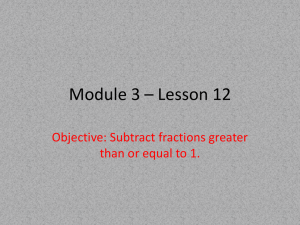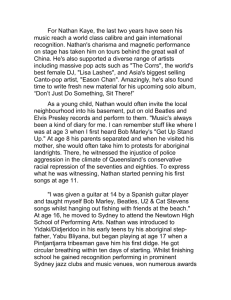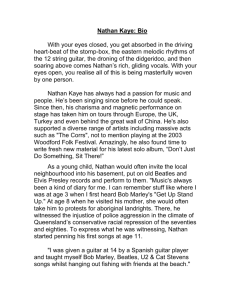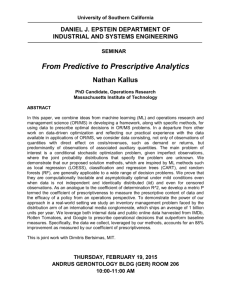here - Wordsmithcrafts
advertisement
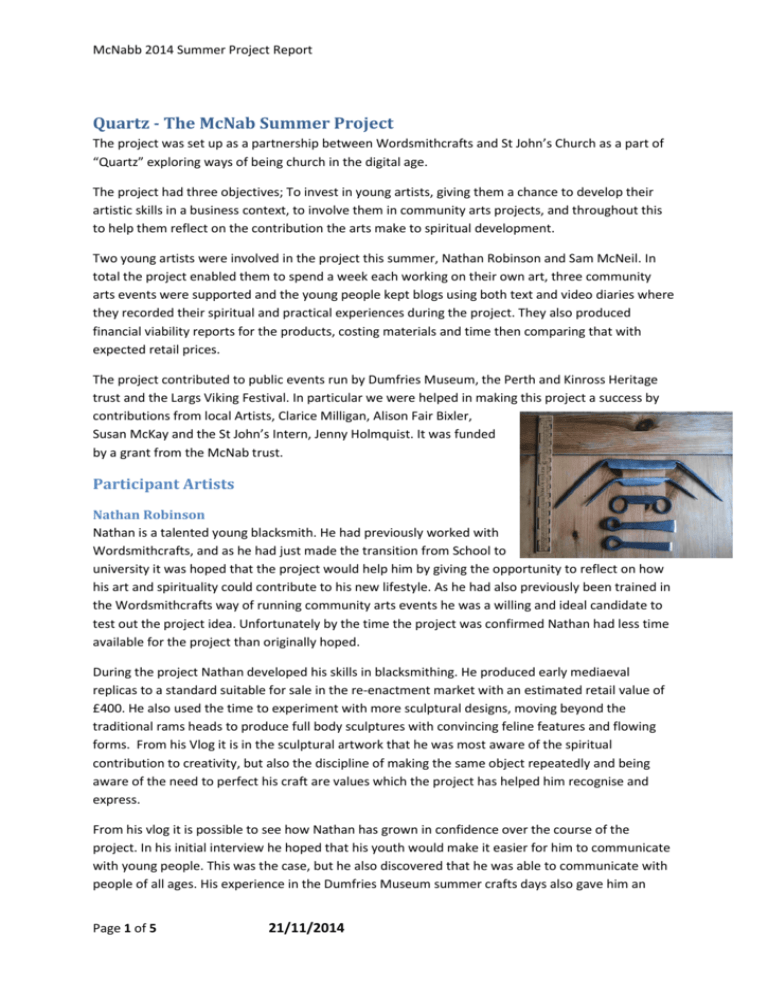
McNabb 2014 Summer Project Report Quartz - The McNab Summer Project The project was set up as a partnership between Wordsmithcrafts and St John’s Church as a part of “Quartz” exploring ways of being church in the digital age. The project had three objectives; To invest in young artists, giving them a chance to develop their artistic skills in a business context, to involve them in community arts projects, and throughout this to help them reflect on the contribution the arts make to spiritual development. Two young artists were involved in the project this summer, Nathan Robinson and Sam McNeil. In total the project enabled them to spend a week each working on their own art, three community arts events were supported and the young people kept blogs using both text and video diaries where they recorded their spiritual and practical experiences during the project. They also produced financial viability reports for the products, costing materials and time then comparing that with expected retail prices. The project contributed to public events run by Dumfries Museum, the Perth and Kinross Heritage trust and the Largs Viking Festival. In particular we were helped in making this project a success by contributions from local Artists, Clarice Milligan, Alison Fair Bixler, Susan McKay and the St John’s Intern, Jenny Holmquist. It was funded by a grant from the McNab trust. Participant Artists Nathan Robinson Nathan is a talented young blacksmith. He had previously worked with Wordsmithcrafts, and as he had just made the transition from School to university it was hoped that the project would help him by giving the opportunity to reflect on how his art and spirituality could contribute to his new lifestyle. As he had also previously been trained in the Wordsmithcrafts way of running community arts events he was a willing and ideal candidate to test out the project idea. Unfortunately by the time the project was confirmed Nathan had less time available for the project than originally hoped. During the project Nathan developed his skills in blacksmithing. He produced early mediaeval replicas to a standard suitable for sale in the re-enactment market with an estimated retail value of £400. He also used the time to experiment with more sculptural designs, moving beyond the traditional rams heads to produce full body sculptures with convincing feline features and flowing forms. From his Vlog it is in the sculptural artwork that he was most aware of the spiritual contribution to creativity, but also the discipline of making the same object repeatedly and being aware of the need to perfect his craft are values which the project has helped him recognise and express. From his vlog it is possible to see how Nathan has grown in confidence over the course of the project. In his initial interview he hoped that his youth would make it easier for him to communicate with young people. This was the case, but he also discovered that he was able to communicate with people of all ages. His experience in the Dumfries Museum summer crafts days also gave him an Page 1 of 5 21/11/2014 McNabb 2014 Summer Project Report opportunity to experience using an art activity in a way which allowed him to express his own beliefs and help other people to visualise the things which were important to them. Nathan helped test the usefulness of the “sensings” framework in this context, laying the groundwork for more intentional use later in the project. The importance of Informal conversations in the van travelling to and from events, or with people like our hosts in Blairgowrie, as well as time to just stop and appreciate the colours in the scenery after a day’s work should not be underestimated. The practice based planning approach allowed the project to take advantage of unforeseeable opportunities to raise awareness of the sensings. After critical theological reflection on these experiences we planned activities to use at a later date. Sam McNeil Sam was also familiar with the re-enactment world, and had previously been hired (independently of Wordsmithcrafts but at the same event) to work in Lindisfarne abbey interpreting the construction of the Lindisfarne gospels for the general public. Building on the experience of previous community arts events, in Blairgowrie and Dumfries museum, the project developed a training day facilitating Sam in adapting his historical interpretation skills to use them in a public art project with the emphasis on helping the general public think about spiritual development. The craft he chose to use in this situation was net making which was also a skill which he wished to develop. Sam also spent time developing his ceramics skills. In order to provide a depth of technical knowledge in this area Wordsmithcrafts arranged to work with other local artists. Sam experimented with new techniques and his blog outlines what he learned as well as his thinking about commercial viability when selecting projects. We carried out two firings, one in a controlled modern kiln with “proper potter” and another experiment with a more rough and ready approach. At time of writing the final raku firing of the proper pots is still to be completed (due to ill health). The larger pieces did not survive the experimental firing, but viable pieces were produced and a lot was learned in the experiment with plans to improve the technique being identified. In his blog Sam describes the spiritual development component, particularly in the community arts setting of the project very well. As he says in his blog “affecting the world around us just by being in it”. He also describes the net making activity, which he thought about, developed and put into practice during the project. Jenny Holmquist Jenny worked with the project as part of her time at St Johns. This meant that even though she is a similar age and at a similar stage in life as Nathan and Sam, she was not simply a young person participating in the project, but had an overview of why the project was being carried out, and a leadership role within it. She managed this very well, and provided another person for Sam and Nathan to discuss things with, rather than everything coming through Simon. Page 2 of 5 21/11/2014 McNabb 2014 Summer Project Report Jenny made the observation that the “sensings” can be quite difficult to understand the significance of, and that focusing on one of them at a time is helpful. The language does not feel natural. During the project she gained a greater understanding of them, and commented that they could probably not be explained to her and were something that it was better that she worked out herself. She also noticed how the re-enactment community, which was the context in which much of this project was worked out, is in some ways separate from the general public. There is a large amount of background knowledge, equipment and shared interests held by re-enactors which can make the environment feel exclusive to outsiders. Perhaps this means that the project was able to operate in ways which would not be possible if it were not for the skills and efforts of all those involved. Community Arts Blairgowrie This event was one where Wordsmithcrafts was hired to interpret the archaeology of the local area by providing a blacksmithing display. Jenny, Nathan and Simon participated. In terms of the project it gave a chance to think about the sensings and intentionally make the event a pilgrimage for those involved. It also gave Nathan an opportunity to participate in a public even where his artistic skills were used in a business and community setting which is one of the ways in which artists earn their income. http://www.glenshee-archaeology.co.uk/news.php?d=5 Dumfries Museums Wordsmithcrafts designed a programme of craft workshops as a part of Dumfries Museum’s summer events. The theme was a medieval merchant’s house, and since religion was much more closely intertwined into daily life in the pre-modern era this meant that links between craft and spiritual development were easy to facilitate. It was also another example of using artistic skills in a community business context. The museum was very happy with the programme, and with Nathans contribution to it. It is hoped to carry out similar activities in the future. Largs Labyrinth Working with the Episcopal church in Largs, and the Viking festival committee, the project set up a labyrinth on the prom at Largs. We used this as a visual focus for two days of the festival. This event featured the most focused attempt to use the “sensings” framework. In the other community arts events the spiritual development aspects were woven into the way of carrying out an activity which was already planned and arranged. Building the Labyrinth in Largs contributed to the overall events programme of the Largs Viking festival, but also provided a unique contribution which would not have been present otherwise. The days we provided the labyrinth for were during the week when the town is usually less busy but there was still a reasonable flow of people using the labyrinth and talking with the “pilgrims”. All the contacts with the general public were positive, and while similar activities have attracted more in depth responses in locations such as Lindisfarne abbey the fact that the general public would take time out from shopping at the continental market to reflect on their Page 3 of 5 21/11/2014 McNabb 2014 Summer Project Report spiritual development is an indicator of success. Our contribution was also received favourably by the market traders and re-enactors who live in the village, as well as the local churches. We handed out about 200 labyrinth cards to people who actively engaged to take away. This project has been inspired by the methodology of liberation theology. Starting with Praxis, and developing the project in actual circumstances with the people involved working it out as it happens. In preparation I kept a blog of my journey to a Viking festival in Norway at the beginning of the summer, and then reflected and wrote about it on my return. Nathans participation in the project, and his reflections on it, further tested the usefulness of the “sensings” the paperwork and helped to form the project as it happened. This allowed the project to be flexible and adapt to the needs of those involved, it also highlighted the importance of conversations with members of the public and others not directly involved with the project (such as our hosts at Blairgowrie) in achieving the projects aims, in particular the spiritual development aspects. By going out and expecting to find “God in friend and stranger” those involved in the project have done so in ways in which trying to precisely define what this would look like from a particular religious position might have overlooked. Now that the summer is over it is time to reflect and examine whether the project has achieved its aims. The delay in confirming the start of the project meant that some of the proposed activities did not take place, but examples of the full range of activities proposed were tested. All those who participated felt that this was a worthwhile use of their time, and that they have grown as a result of it. This report hopefully shows that the project has demonstrated the worth of the activities, and the accompanying record of images, blog and Vlog which will be available online through the Wordsmithcrafts website will give more details about what each activity involved and suggest ideas for future activities and projects. Page 4 of 5 21/11/2014
